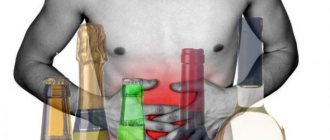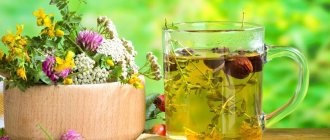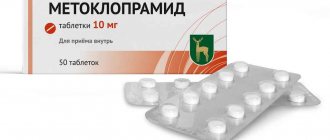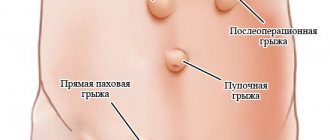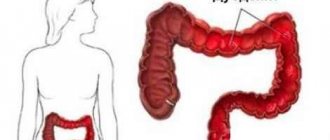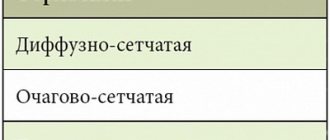Reflux is a generalized name for a condition in which reverse movement of the contents of internal hollow organs is observed. In particular, reflux with gastritis-duodenitis is a movement in the opposite direction to the natural direction of the contents of the duodenum, that is, into the stomach.
What symptoms indicate duodenitis and how to treat this disease?
Why is this pathology dangerous? With short-term duodenal gastric reflux, no special consequences for the body are observed. But the long course of the disease is fraught with quite serious complications that occur against the background of underlying pathologies, gastritis and duodenitis. This is the possibility of chemical-toxic gastritis, gastroesophageal reflux and stomach ulcers.
The precursors of duodenogastric reflux can be any gastrointestinal pathology: gastritis, pancreatitis, duodenitis, esophagitis. As an independent disease, reflux gastritis duodenitis is observed relatively rarely - in approximately 30% of cases.
It is believed that even in healthy people, the release of the contents of the duodenum into the antrum of the stomach occurs in approximately every tenth person. This happens mainly during sleep or when performing heavy physical work and is completely asymptomatic, so such conditions are considered a syndrome and not a disease.
Duodenogastric reflux. Recommendations
It has been noted that apparently healthy people can also have symptoms of GHD. Gastroenterologists have not reached a consensus regarding duodenogastric reflux. Some believe that the signs of GHD are the onset of the disease, others that almost all healthy people are susceptible to these signs. We are talking about a feeling of heaviness in the stomach or belching, which sometimes occurs during strength and physical exercise or even in sleep.
The advice may be very simple - consult a doctor, even if the symptoms of the disease are mild, in order to prevent further development of the disease.
What symptoms of duodenogastric reflux should serve as a signal to visit a gastroenterologist? Pay attention to spastic pain in the epigastric region that periodically occurs after eating, as well as nausea, belching of air or eaten food, and vomiting of bile. You may feel disturbed by a feeling of abdominal distension or bloating. Symptoms of the disease include a yellow coating on the tongue and a bitter taste in the mouth. Diagnosis of GHD is not difficult; when you contact a specialist with complaints, the doctor gives a referral for fibrogastroduodenoscopy (FGDS), in some cases it is recommended to do contrast radiography of the stomach and duodenum. After the research, the doctor prescribes treatment. It must be comprehensive, and first of all, aimed at curing the underlying disease.
Nutrition for duodenogastric reflux
Recommendations and principles of treatment The main condition for successful therapy is adherence to nutritional rules and maintaining a healthy lifestyle. The doctor will advise you to give up bad habits - smoking, drinking alcohol. If you are additionally taking medications - aspirin, caffeine, choleretic drugs, you must notify your doctor about this and consult with him about the need to change or shorten the course of treatment.
One of the ways to solve the problem of GHD may be to follow a diet and control body weight.
The doctor will prescribe the necessary diet, which will become an important and integral part of the therapy. Patients are advised to monitor their lifestyle. Eat five or six times a day in small portions, avoiding overeating. You may need to grind your food in a blender, or make sure you chew it thoroughly. Preference should be given to dishes baked in a steamer or oven. Fill your diet with pureed cereals, bran, puree soups, lean meats and fish. You should have milk, yogurt on your table, as well as non-sour berries, fruits and vegetables. A diet for duodenogastric reflux requires excluding the following foods: onions, garlic, tomatoes, citrus fruits, sour fruits, fresh soft bread, carbonated drinks, chocolate and coffee. Do not eat smoked, spicy, fatty and salty foods, as well as some fermented milk products. After eating, you should not engage in any type of physical activity, and also do not lie down or bend over.
Diet for duodenogastric reflux
The principle of proper nutrition for GHD is practically no different from the diet used in the treatment of gastritis.
General recommendations are to exclude from the diet (or minimize the consumption of) fried, fatty, spicy foods, give up alcohol and smoking, citrus fruits, chocolate products, fresh wholemeal bread, fresh tomatoes, garlic.
The diet for GHD should be based on the following dishes:
- vegetarian soups, broths from lean meats;
- vegetable/fruit salads (it is prohibited to use sour and difficult-to-digest foods);
- yoghurts, low-fat cottage cheese;
- mineral water, dried fruit compote.
In this case, you should follow recommendations that will help reduce the load on the gastrointestinal tract and prevent the progression of inflammatory processes:
- a regimen of fractional meals should be provided (three main meals and 2 to 3 additional meals between them) with a reduced dosage of foods;
- a menu should be created based on easily digestible products that do not irritate the gastric epithelium;
- chew food thoroughly - enzymes contained in saliva will ensure preliminary digestion of food before it enters the digestive tract;
- It is not recommended to take a horizontal position (that is, lie down) for an hour after eating;
- with duodenal reflux gastritis, physical activity associated with the use of the abdominal muscles should be avoided for 40–60 minutes after eating;
- you should not wear tight clothes or use tight belts, which can increase intra-abdominal pressure, causing reflux;
- daily walks are shown (minimum one-hour walks).
Drug treatment
- Drug therapy for duodenogastric reflux aims to normalize all functions of the gastrointestinal tract and regulate the motor-evacuation function of parts of the digestive system. A drug that improves intestinal motility is Trimedat.
- Prokinetics (Domperidone, Cerucal) show good results in therapy. They help the rapid absorption and digestion of food, as well as the movement of its remains through the small intestine.
- To neutralize the effect of the contents of the duodenum on the gastric mucosa, drugs are prescribed - (Omez, Nexium).
- Antacid medications - Almagel, Gaviscon, Phosphalugel - help get rid of heartburn.
It must be remembered that treatment of duodenogastrol reflux should begin when the first symptoms of the disease appear. By consulting a doctor in the early stages of the disease, you prevent the development of a serious complication - reflux gastritis.
A pathology such as duodenogastric reflux (there is no code in ICD-10) is detected in 15% of seemingly healthy people. This is a disease of the digestive tract, which is characterized by the reflux of bile acids and duodenal enzymes into the stomach. The disease very rarely occurs on its own. In most cases, the development of duodenogastric reflux occurs as a result of other diseases, such as gastritis, ulcers, gastroesophageal reflux disease, but there are many other reasons.
Duodeno gastric reflux: 11 main manifestations and review of medications for treatment
GastroenterologyTherapist about duodenogastric reflux: from causes to modern methods of treatment and prevention Not always the entry of the contents of the duodenum into the lumen of the stomach can be considered a disease: many experts are convinced that physiological duodenogastric reflux occurs in healthy people without a negative effect on the body (this condition is present mainly at night).
Clinical manifestations develop with regular, long-term duodenogastric reflux. This causes a change in acidity in the stomach, leading to damage to its mucous membrane and indigestion. All of these disorders influence the onset of symptoms.
Duodenogastric reflux is a companion to many diseases of the gastrointestinal tract, but in a third of patients it is an independent disease and occurs with equal frequency in men and women.
Normal digestion in the upper gastrointestinal tract
Normally, food entering the stomach from the esophagus undergoes mechanical mixing and the stage of digestion under the influence of gastric juice, then enters the duodenum, where it is further processed by enzymes and acids produced by the liver and pancreas.
There is a border between the human stomach and duodenum - the pyloric sphincter, the pylorus. Food soaked in gastric juice enters the pyloric section of the stomach, where the receptors are irritated by hydrochloric acid, which provokes the opening of the sphincter and the evacuation of the food bolus.
Along with this, contraction of the stomach muscles occurs, as a result of which the contents pass portionwise into the lumen of the duodenum. The bolus of food, which has an acidic reaction, changes the acidity in the duodenum, and the pylorus closes, preventing food from refluxing into the stomach.
Casting conditions
The reflux of the contents of the duodenum into the lumen of the stomach occurs due to the presence of the following conditions:
- insufficiency of the pyloric part of the stomach;
- increased pressure in the duodenum;
- chronic inflammatory processes in the duodenum (duodenitis);
- slowing down the evacuation of food from the stomach and/or duodenum.
Provoking factors
The main conditions that can trigger the occurrence of these pathological changes:
- hiatal hernia;
- smoking:
- pregnancy;
- poor nutrition:
- alcohol abuse;
- obesity;
- wearing belts and tight clothing;
- surgical interventions on the stomach, bile ducts, gallbladder, pancreas or duodenum;
- acute and chronic pathologies of the digestive tract;
- uncontrolled use of certain medications (calcium channel blockers, non-steroidal anti-inflammatory drugs).
What happens in the digestive tract during duodenogastric reflux?
Under the influence of various pathological factors, the smooth digestive process in the stomach and duodenum is disrupted.
When the contents of the duodenum enter the stomach cavity, the mucous membrane of the latter is damaged under the influence of aggressive substances.
Enzymes and acids synthesized by the liver and pancreas are able to dissolve the protective mucous layer lining the stomach from the inside, and the gastric epithelium becomes vulnerable to the effects of hydrochloric acid.
Inflammation occurs, which with regular duodenogastric reflux becomes chronic. In some cases, duodenogastric reflux can provoke the development of gastroesophageal reflux disease or be combined with it.
Clinical manifestations
The main symptoms most often encountered with duodenogastric reflux:
- bitter taste in the mouth;
- belching of air or food;
- pain in the stomach;
- nausea, vomiting of bile;
- heaviness, feeling of fullness in the epigastrium;
- yellowish coating on the tongue;
- heartburn;
- dry cough;
- hoarseness of voice (in rare cases, loss of voice);
- bloating (flatulence);
- pain when food passes through the esophagus.
Duodenogastric reflux may not be accompanied by the development of symptoms for a long time.
Complications
Long-term and/or intense negative effects of duodenogastric reflux on the digestive system can cause the development of the following pathological conditions:
- gastroesophageal reflux disease - reflux of gastric contents into the final section of the esophagus (in turn, leading to other serious complications - peptic ulcers of the esophagus, Barrett's syndrome, esophageal strictures, bleeding from esophageal ulcers, esophageal adenocarcinoma);
- chronic gastritis (toxic-chemical gastritis type C).
Diagnostics
- Fibrogastroduodenoscopy. Using this method, you can identify the presence of bile in the stomach, signs of duodenitis, gastritis, esophagitis, erosion, ulcers and any pathological changes caused by duodenogastric reflux.
- Plain radiography of the stomach and duodenum after contrast. Detects hiatal hernia, tumor formations, esophageal strictures, and so on.
- pH-metry (including daily).
It is used to identify changes in acidity in the esophagus and stomach, and helps to assess the duration and number of duodenogastric refluxes. - Manometry. Used to assess motility and peristalsis of the upper digestive tract.
- Ultrasound examination of the liver, biliary system, pancreas and so on.
Drug treatment
Medicines prescribed for the treatment of DRG:
- Proton pump inhibitors (Pariet, Losek, Nolpaza, Lancid, Nexium) and H2-histamine receptor blockers (Ranitidine, Famotidine). Prescribed to reduce the production of hydrochloric acid.
- Prokinetics (Motilium, Cerucal). They accelerate the transition of the food bolus from the stomach to the duodenum and improve digestion, relieve nausea, vomiting, discomfort and heaviness in the stomach.
- Ursodeoxycholic acid preparations (Choludexan, Livodexa, Ursofalk, Urdoxa, Ursosan). They bind and neutralize bile acids, preventing their negative effects on the inner lining of the stomach and esophagus.
- Sorbents (Enterosgel, Polysorb, Smecta). Helps neutralize and remove enzymes and acids from the digestive tract.
- Antispasmodics (Trimedat, No-shpa). Normalize motility and peristalsis of the gastrointestinal tract, relieve discomfort and pain.
- Antacids (Gaviscon, Gastal, Maalox, Rennie). The drugs provide protection to the stomach and esophagus from the damaging effects of hydrochloric and bile acids and enzymes.
Influencing the factor that caused the development of duodenogastric reflux (lifestyle changes) is one of the key points of treatment.
Lifestyle modification
Lifestyle changes:
- weight normalization, maintaining normal body weight;
- strict adherence to diet and nutrition;
- quitting smoking and drinking alcoholic beverages;
- wearing loose clothing, avoiding tight belts;
- use medications only as prescribed by a doctor;
- timely treatment for any disease of the digestive tract.
Diet for duodenogastric reflux
Dietary recommendations make up the lion's share of all treatment. It is very important to follow the following nutritional rules:
- eat food in small portions, preferably 5-6 times a day, avoiding overeating and long time intervals between meals;
- do not eat at night (small meals are allowed three hours before bedtime);
- all food should be warm;
- do not lie down after eating;
- exclude physical activity, bending the body after eating (optimally - sit quietly, supporting the body in an upright position).
Special attention should be paid to preparing food and choosing products:
| Allowed to use | Not recommended for use |
|
|
Conclusion
If the patient conscientiously follows all the doctor’s recommendations, the prognosis for the course of the disease is predominantly favorable.
Sometimes there are “advanced” cases, the presence of which is explained by late seeking medical help and/or ignoring doctor’s advice regarding lifestyle changes and adherence to drug therapy.
The development of complications is often also a consequence of untimely treatment and the patient’s inattention to his own health.
We have put a lot of effort into making sure you can read this article and would welcome your feedback in the form of a rating. The author will be pleased to see that you were interested in this material. Thank you!
(14 4,79 of 5) Loading...If you liked the article, share it with your friends!
- Duodenogastric reflux
Source: https://UstamiVrachey.ru/gastroenterologiya/duodenogastralnij-reflyuks
general information
Duodeno-gastric reflux develops when there is a violation of duodenal patency, which results in an increase in pressure in the duodenum. In this case, the closing function of the pylorus of the stomach is noticeably weakened. The pyloric sphincter ceases to properly perform its basic functions, and food that has managed to be partially digested and moves into the intestines returns back to the stomach.
Statistics show that the disease occurs in approximately the same number of men and women. It is often diagnosed in student youth.
Causes of duodenogastric reflux
For a long time, it was widely believed that the cause of duodenal gastric reflux is the body’s protective reaction to the occurrence of inflammatory processes in the gastric mucosa, when gastric juice with high acidity enters the duodenum. With the reverse release of duodenal juice into the stomach, it becomes alkalized, which supposedly reduces acidity, preventing further damage to the gastric epithelium.
Currently, a series of special studies have proven that this opinion is erroneous - when duodenal juices enter the stomach, they provoke further damage to the mucous barrier. This is facilitated by the penetration of hydrogen ions from the duodenal fluid into the submucosal layer of the stomach, which stimulate the activity of the antral glands, which specialize in the secretion of gastrin, which increases acidity rather than reduces it.
In fact, the development of GHD is influenced by many factors, from dysfunction of the motor function of the stomach and duodenum to insufficiency of the pyloric region of the stomach.
Reasons for the development of the disease
As causes of duodenogastric reflux, gastroenterologists identify factors such as:
- pancreatitis;
- lack of the hormone gastrin;
- hepatitis;
- hiatal hernia;
- cholecystitis;
- dysbacteriosis;
- diabetes;
- syndrome of incomplete rotation of the short bowel and intestines;
- obesity;
- inflammatory processes in the gallbladder and pancreas;
- helminthic infestation;
- insufficiency and other diseases of the pancreas;
- pregnancy;
- surgical interventions on the organs of the digestive system (cholecystectomy, suturing of ulcers and other operations).
The following can also lead to the development of pathology:
- smoking;
- alcohol addiction;
- frequent consumption of too hot, spicy and fatty foods;
- irregular meals;
- unbalanced diet, lack of liquid food in the diet;
- long-term use of antispasmodics, antibiotics;
- frequent stress.
Classification of duodenogastric reflux
The clinical picture of reverse movement of intestinal contents depends on the degree of damage to the gastric epithelium, according to which reflux is classified:
- Superficial gastritis, duodenitis reflux is a pathology that does not lead to dystrophy of the gastric glands, but the surface layer of the epithelium is already beginning to collapse along with its regenerative function. With prolonged reflux, dystrophy affects the gland cells, and infiltration of the mucous membrane occurs.
- Catarrhal duodeno-gastric reflux against the background of gastritis occurs due to intoxication with chemicals, stale foods, under the influence of long-term use of certain medications or as a result of food allergies. In this case, inflammation of the mucous membrane occurs, turning into edema and degeneration of the epithelium; as a result of infiltration of leukocytes, secretory activity is activated, which subsequently gives way to secretory insufficiency. In some cases, inflammation spreads to the intestines, causing gastroenterocolitis.
- Erosive reflux gastritis duodenitis, as the name suggests, is characterized by the appearance of erosions that are localized in the epithelial layer without affecting the underlying ones; during healing, scar tissue does not form. The cause of this type of pathology is the release of bile that occurs during alcohol and chemical intoxication, under the influence of stress. Among the complications, endocrine pathologies and somatic disorders are often observed.
- Biliary reflux gastritis duodenitis is characterized by a disorder such as dyskinesia of the bile ducts, accompanied by malfunction of the sphincters. The cause of the occurrence is disruptions in the synchronous motility of the gallbladder and bile ducts, caused by poor nutrition and psycho-emotional disorders.
It should be noted that erosive gastritis reflux and superficial duodenitis reflux are the mildest forms of the disease, which are often asymptomatic and without irreversible consequences.
Symptoms of the disease
Signs of duodenogastric reflux can often be confused with symptoms of other diseases of the digestive system. But this disease has its own distinctive feature. All symptoms begin to appear approximately half an hour after eating. This is how much time is usually needed for food to begin processing in the stomach and move on to the next stage. In the presence of a disease, this established process malfunctions, as a result of which food particles, along with enzymes and acids, fall back into the stomach and affect its mucous membrane.
Duodeno-gastric reflux is accompanied by the following symptoms:
- Stomach ache. Usually they are localized in the upper part, are paroxysmal in nature, and have medium or high intensity.
- Flatulence.
- Heartburn that occurs almost immediately after eating food.
- Belching with air (in some cases with sour contents).
- Regurgitation of sour contents or small amounts of food.
- Bitter taste in the mouth.
- The appearance of a white or yellowish coating on the tongue.
- Nausea, vomiting with bile (in cases where the disease progresses).
Since the diagnosis of “duodeno-gastric reflux” disrupts the digestive processes, nutrients are no longer absorbed fully. As a result, vitamin deficiency develops, which is characterized by:
- weight loss;
- redness and swelling in the corners of the mouth;
- deterioration of the condition of nails, skin and hair.
If you detect the above-described symptoms of the disease, you should immediately contact a gastroenterologist, who will conduct an examination and prescribe the correct treatment.
Symptoms
The manifestations of this pathology are few, but they are similar to the symptoms of many other gastrointestinal diseases - gastritis, esophagitis, and some forms of pancreatitis. In many cases, pathology is detected by chance during fibrogastroduodenoscopy, since it is often asymptomatic.
Among the main signs of duodenogastric reflux, the following should be noted:
- discomfort and pain observed in the epigastric region (mainly spastic in nature), occurring after eating due to increased activity of the digestive tract;
- a feeling of heaviness, fullness, swelling in the epigastric region, observed immediately after eating;
- the presence of reflux can be indicated by a yellowish coating on the tongue and a bitter taste in the mouth;
- sometimes heartburn is observed, which usually indicates excessive secretion of hydrochloric acid, but also occurs with low acidity of the stomach;
- nausea accompanied by vomiting, in which bile is present in the vomit - also evidence of gastroduodenal reflux;
- Often with reflux there is an involuntary belching, the cause of which is precisely the release of food with bile from the intestines into the stomach.
It should be noted that an alkaline environment predominates in the intestines, and an acidic environment in the stomach. When bile mixes with pancreatic juice, an aggressive substance is obtained that is able to destroy the mucous barrier of the stomach walls and begin to decompose internal tissues. Long-term releases of duodenal juice are dangerous because they cause metaplasia of the gastric epithelium, inflammation of the mucous membrane, the appearance of erosions and ulcers.
Degrees of the disease
Depending on how long ago the development of the disease began and how much bile acids are contained in the parts of the stomach, the pathology is divided into several degrees:
- Duodeno-gastric reflux of 1st degree. This is the initial stage of the disease, during which a minimal amount of duodenal contents is detected in the stomach. As a rule, at this stage there are no signs of the disease. In more rare cases, the patient may notice some symptoms, but does not pay attention to them and thinks that they arose due to poor nutrition and will soon disappear on their own.
- Duodeno-gastric reflux of 2 degrees. It is at this stage that most patients learn about their disease. During diagnosis, enzymes and duodenal acids are detected in the fundus of the stomach. Periodically occurring symptoms force the patient to suspect the presence of an illness and seek help from a gastroenterologist.
- Duodeno-gastric reflux of the 3rd degree. This form of the disease is considered to be the most complex and advanced. The contents of the duodenum can be found in the lower esophageal sphincter and at the bottom of the stomach. The third degree is accompanied by a pronounced appearance of all the symptoms of the disease, which cause great discomfort to the patient.
Diagnosis of the disease
Often duodenogastric reflux can be diagnosed completely by accident. For example, this can happen during a preventive examination or a comprehensive examination, the purpose of which was to identify a completely different disease of the digestive system.
In other cases, special diagnostics will be required. A visual examination of the patient will give virtually no results. The only thing the doctor can note is a white or yellowish coating on the tongue. Auscultation (listening) and palpation (palpation) of the abdomen are also performed. During these procedures, the presence of pain, peristaltic noises and rumbling in the abdomen is determined.
To identify duodeno-gastric reflux, instrumental research methods are also necessary. It can be:
- antroduodenal manometry;
- measuring the acidity of gastric juice;
- electrogastrography.
If necessary, auxiliary diagnostic methods can be used:
- Ultrasound;
- FGDS;
- plain radiography;
- differential diagnosis.
Before confirming the diagnosis of “duodeno-gastric reflux”, the gastroenterologist will have to completely exclude the presence of ailments with similar symptoms:
- gastritis;
- ulcer;
- duodenitis;
- acute cholecystitis;
- acute pancreatitis;
- acute cholangitis;
- cholelithiasis.
Diagnostics
Despite the fact that the symptoms of the disease are similar to those of many other gastrointestinal problems, an experienced specialist can easily make a diagnosis. If you suspect a disease, it is important to immediately carry out all the necessary tests. Previously, the leading research method was fibrogastroduodenoscopy, which is now used much less frequently.
In addition, the patient must undergo:
- analysis of daily pH-metry, which determines the acidity of different parts of the stomach;
- Ultrasound of the abdominal cavity;
- X-ray of the stomach and duodenum with contrast;
- electrogastroenterography.
Depending on the patient's complaints or the doctor's decision, additional studies may be prescribed. The examination is carried out comprehensively, that is, it includes different methods - in this way the diagnosis will be determined more accurately. The success of treatment of duodenogastric reflux directly depends on this.
The examination is carried out comprehensively
Drug treatment
The use of drugs for duodenogastric reflux is carried out on an outpatient basis. The need for hospitalization arises only in cases of severe pain, severe vomiting and the development of various complications of the disease, as well as for the purpose of conducting additional examinations.
The main goal of drug treatment is to restore the functionality of the digestive system. For this purpose, the patient may be prescribed:
- Prokinetics for faster digestion of food, its better absorption and movement through the small intestine. Such drugs include Domperidone and Cerucal.
- Trimedat will help improve intestinal motility.
- To protect the stomach from the effects of the contents of the duodenum, Nexium and Omez are used.
- Gaviscon, Phosphalugel, Almagel will help get rid of heartburn.
- Mosapride citrate will enhance peristalsis of the upper gastrointestinal tract.
- Ursodeoxycholic acid preparations will make the contents of the duodenum water-soluble, which will reduce its aggressive effect on the stomach.
In cases where drug treatment does not bring the desired results, a decision is made on the need for surgical intervention. But here everything is not so simple. The fact is that it is technically very difficult to perform high-quality plastic surgery of the pylorus of the stomach. And the imposition of an anastomosis (anastomosis) between the intestines and the stomach cannot replace and fully perform the functions of the sphincter.
Diet as part of general therapy
Treatment of duodeno-gastric reflux includes adherence to a special strict diet. Patients are allowed to eat:
- vegetable soups without frying;
- boiled, baked or steamed fish;
- lean meat;
- eggs;
- vegetables;
- non-acidic fruits;
- greenery;
- jam;
- compotes;
- honey;
- jelly;
- dried bread.
Meals for duodenogastric reflux should be fractional, which means eating small portions up to six times a day.
As for restrictions, for the entire period of treatment the patient is prohibited from:
- fried dough;
- fresh bread and pastries;
- lard and fats of animal origin;
- mushrooms;
- spices and seasonings;
- chocolate;
- legumes;
- cakes with butter and butter creams;
- ice cream.
Possible complications
Duodeno-gastric reflux can cause the development of other, more serious diseases and pathologies. For example, these could be:
- Toxic-chemical gastritis C. Usually the disease occurs as a result of improper or incomplete treatment of duodenogastric reflux. The disease is an inflammation of the gastric mucosa due to constant exposure to pancreatic juice and bile.
- Adenocarcinoma. This is a malignant neoplasm of the esophagus, which occurs as a result of changes in its mucous membrane, proliferation and degeneration of its cells. The main reason why this process occurs is the entry of stomach contents into the esophagus.
- Gastroesophageal reflux disease. Accompanied by reflux of stomach and duodenal contents into the esophagus.
In especially severe cases, complications may arise in the form of “loss” of the stomach and duodenum from the normal act of digestion. In such a situation, the patient will not be able to feed on his own; he will be fed by introducing special substances through the blood.
Pathogenetic mechanism for the development of complications in GHD
In pathological duodenogastric reflux, bile in the composition of refluxate moves retrogradely from the duodenum to the organs located above - the stomach and esophagus. Bile acids, trypsin, lysolecithin - components of duodenal contents - damage the mucous membrane. Bile acids have the most aggressive effect during reflux of duodenal contents.
Unconjugated bile acids and trypsin have a more toxic effect at slightly alkaline and neutral pH; the damaging effect in duodenogastric reflux increases with drug suppression of acid reflux. Their toxicity is largely due to their ionized form, which allows the acids to easily penetrate the esophageal and gastric mucosa.
As a result of the action of bile acids contained in bile on the gastric mucosa, changes in the surface epithelium of the stomach of a dystrophic and necrobiotic nature occur for a long time, which leads to the development of reflux gastritis - gastritis C. With an existing Helicobacter pylori infection, the damaging effect of refluxate on the gastric mucosa increases.
In the presence of DGR, aggressive contents are thrown into the overlying sections, which causes disturbances in the functioning of the digestive system, membrane and cavity digestion is affected, the possibility of absorption of food ingredients with microelements and vitamins is affected, and the water balance changes.
A sign of the negative effects of GHD are signs of atrophy, metaplasia and dysplasia, this is dangerous due to the risk of developing stomach or esophageal cancer. In addition, bile in combination with pancreatic juice, due to its aggressiveness, has a destructive effect on the mucous barrier in the stomach, while the reverse diffusion of hydrogen ions increases. As a result of these processes, erosive and ulcerative lesions of the gastric mucosa occur.
Prevention
To prevent the occurrence of such an unpleasant disease as duodeno-gastric reflux, it is necessary:
- regulate your diet;
- avoid overeating;
- promptly seek help from specialists if problems arise with the digestive system;
- do not self-medicate and take medications only under medical supervision;
- engage in physical therapy and perform exercises to strengthen the abdominals and muscle corset.
Be healthy!
Duodenogastric reflux is a disease in which retrograde reflux into the stomach from the duodenum occurs. Most often, the pathological process is classified as a syndrome that accompanies other diseases of the digestive tract.
Prevention of duodenogastric reflux
To prevent the occurrence of this condition, you need to monitor your diet and diet. Food should always be taken evenly and overeating should not be allowed. After eating, it is not recommended to lie down or bend over; avoid physical activity, which can lead to an increase in intra-abdominal pressure.
You should limit the consumption of coffee, chocolate, fresh baked goods, fatty and fried foods, and alcohol. Quitting smoking plays an important role in disease prevention.
Causes of the disease
Duodenogastric reflux is the reflux of the contents of the duodenum into the stomach cavity.
Duodenogastric reflux can occur due to various causes. In most cases, the occurrence of a pathological condition is diagnosed as motility disorders in the digestive tract.
Bile acids and pancreatic enzymes damage the protective barrier in the gastric mucosa. As a result, reverse diffusion of hydrogen ions occurs into the walls of the stomach.
Against this background, stimulation of the production of gastrin by the antral glands and damage to the lipid membranes of cells is observed. This leads to increased sensitivity to gastric juice.
Retrograde reflux leads to increased pressure in the stomach, which leads to the onset of the disease. Duodenogastric reflux is quite often observed against the background of:
- Gastric ulcer;
- Chronic gastritis;
- Stomach cancer;
- Duodenostasis;
- Violations of the sphincter of Oddi tone;
- DPK.
The occurrence of a pathological condition is quite often observed after surgery to remove the gallbladder. People who have impaired gastric motility are at risk for this disease.
The cause of the pathological condition is quite often systemic diseases of the digestive tract. The development of the disease is most common in smokers. It can also be diagnosed in pregnant females.
A fairly common cause of duodenogastric reflux is a hernia of the diaphragm. With dysbiosis and inflammation, which is observed in the area of the gallbladder and pancreas, a pathological process can also develop.
If a patient loses the tone of the esophageal muscles that separate the duodenum and stomach, this leads to the onset of the disease. During the period of taking medications, the action of which is aimed at reducing the muscle tone of smooth muscles, the development of this disease may be observed. The causes of duodenogastric reflux can be quite varied.
Most often, the pathological process occurs against the background of diseases of the digestive tract or an unhealthy lifestyle.
Symptoms and signs in adults
Duodeno-gastric reflux is the reflux of the contents of the duodenum into the stomach cavity. As an independent disease, it is rare; much more often it is a symptom of another gastrointestinal pathology.
Symptoms of duodenogastric reflux are nonspecific and are characteristic of many diseases of the gastrointestinal tract.
- First of all, these are diffuse, vague pains in the upper abdomen, most often spasmodic, occurring some time after eating.
- Patients complain of increased flatulence, heartburn (with any acidity of the stomach), regurgitation of acid and food, belching of air, vomiting with bile.
- A must-have sensation of bitterness in the mouth and a yellowish coating on the tongue. Long-term reflux can cause serious changes in the stomach and esophagus.
Initially, an increase in pressure in the stomach cavity leads to the development of gastroesophageal reflux disease. Subsequently, bile acids and pancreatic enzymes cause specific changes in the esophageal mucosa, intestinal metaplasia, which can lead to the development of adenocarcinoma - one of the most malignant tumors of the esophagus.

